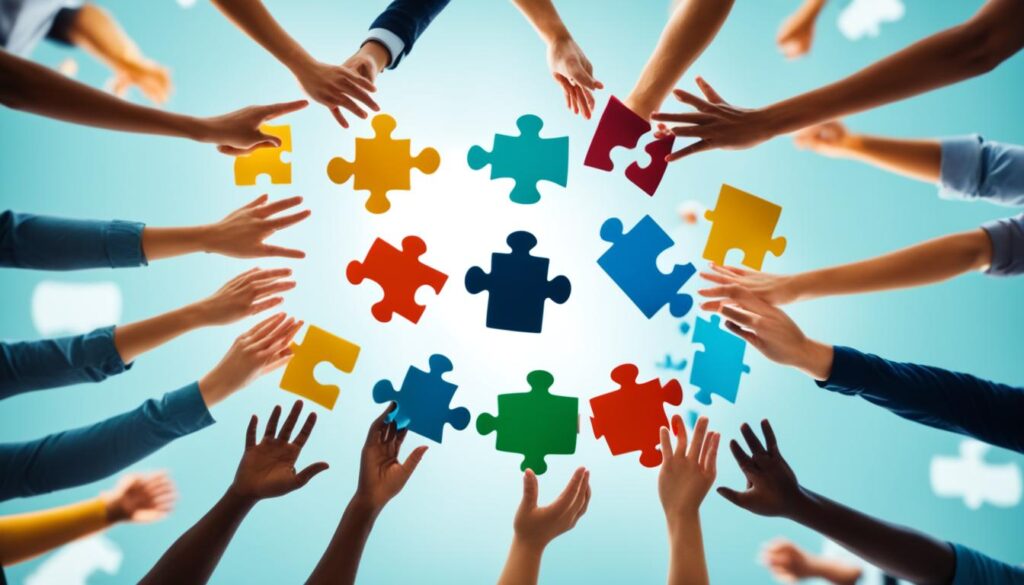Imagine being part of a team where everyone works together seamlessly, ideas flow freely, and communication is effortless. This dream team not only achieves remarkable results but also enjoys the process of collaboration. Such high-performing teams are characterized by strong team dynamics and effective communication skills.
Meet Sarah and Mike, two colleagues who worked in the same department for years but rarely interacted. Sarah, a creative and outgoing individual, preferred brainstorming sessions and open discussions. Mike, on the other hand, was more reserved and analytical, preferring to delve deep into data and work independently.
One day, their manager, Alex, recognized the untapped potential in their complementary skills and decided to assign them a joint project. Initially hesitant, Sarah and Mike realized they needed to bridge their communication styles and align their respective approaches to work effectively as a team.
Through open dialogue and mutual understanding, Sarah and Mike learned to appreciate each other’s strengths and adapted their communication styles accordingly. Sarah embraced more structured methods of presenting ideas to accommodate Mike’s analytical nature, while Mike provided thoughtful feedback on Sarah’s creative proposals.
As they began to collaborate more, Sarah and Mike noticed their work dynamics shifting. Their different perspectives contributed to innovative solutions, and their effective communication created a supportive and productive work environment. Their project was a success, exceeding expectations and earning praise from their colleagues and superiors alike.
This anecdote highlights the importance of team dynamics and effective communication skills in driving collaboration and achieving outstanding results. Building positive team chemistry and understanding individual personalities within the team are essential for enhancing team collaboration and improving communication skills.
Key Takeaways:
- Team dynamics and communication skills are fundamental for successful collaboration and employee engagement.
- Understanding individual personalities and adapting communication styles foster positive team relationships.
- Building trust, accountability, innovation, and collaboration are essential for high-performing teams.
- The role of the manager in fostering team dynamics is crucial, but empowering team members is equally valuable.
- Effective team dynamics require communication, transparency, and a sense of belonging.
Understanding the Importance of Team Dynamics
Team dynamics play a pivotal role in shaping the success and effectiveness of a team. It refers to the emotional and human connections within a team that significantly impact its performance and employee engagement. When team members possess a strong sense of camaraderie and synergy, they are more likely to collaborate effectively and achieve exceptional results. Moreover, fostering positive team dynamics can lead to enhanced creativity and innovation, as members feel comfortable sharing ideas and taking risks. Organizations that prioritize optimizing team dynamics strategies often see improved communication and trust among team members, which in turn drives overall productivity. Ultimately, investing in the development of strong interpersonal relationships within a team is crucial for reaching both individual and collective goals.
One crucial aspect of team dynamics is building positive team chemistry. This involves understanding the different roles that individuals play in a working group and recognizing their unique personalities. By gaining insights into the strengths and preferences of each team member, leaders can foster more intentional and harmonious collaboration within the team.
Trust, accountability, innovation, and collaboration are the cornerstones of high-performing teams. When there is a foundation of trust and accountability, team members feel empowered to take risks, contribute their ideas, and actively participate in achieving collective goals. As a result, team performance and productivity are significantly enhanced.
On the other hand, team conflict and a blame culture can hinder team dynamics and lead to subpar performance. It is essential for organizations to cultivate a culture of open dialogue, where team members feel comfortable expressing their thoughts and concerns. By addressing conflicts constructively and fostering a supportive environment, leaders can nurture a positive team dynamic that fuels growth and success.
Key Points:
- Team dynamics refer to the emotional and human connections within a team that influence its performance and employee engagement.
- Building positive team chemistry requires understanding the different roles individuals play in a working group and recognizing their personalities.
- Trust, accountability, innovation, and collaboration are hallmarks of high-performing teams.
- Team conflict and a blame culture hinder team performance and productivity.
To visualize the importance of team dynamics, refer to the diagram below:
| Benefits of Strong Team Dynamics | Consequences of Weak Team Dynamics |
|---|---|
|
|
Strategies for Building Strong Team Dynamics
Building strong team dynamics is essential for promoting effective team communication, enhancing team synergy, and fostering a collaborative work environment. By implementing proven teamwork development techniques, organizations can cultivate a culture of trust, open communication, and mutual understanding. This section explores various strategies that contribute to building and maintaining robust team dynamics.
1. Create a Shared Purpose
Establishing a shared purpose is a fundamental step in building strong team dynamics. When team members understand and align with the organization’s goals and values, they are more likely to collaborate effectively and work towards a common objective. This shared purpose fosters a sense of unity, encourage collective problem-solving, and boosts team productivity.
2. Foster a Positive Company Culture
A positive company culture plays a vital role in enhancing team dynamics. By promoting transparency, fairness, and respect, organizations can create a supportive environment where team members feel valued and motivated. Encourage regular team-building activities, recognition programs, and open communication channels to nurture a positive work culture that fosters collaboration and meaningful work.
3. Invest in Team Training
Investing in training programs tailored to enhance team communication and collaboration skills can significantly contribute to building strong team dynamics. From workshops on effective communication techniques to leadership development programs, providing opportunities for continuous learning and skill development helps team members understand and adapt to different communication styles, improve conflict resolution abilities, and develop better problem-solving strategies.
4. Delegate Tasks to the Right People
One key aspect of enhancing team dynamics is ensuring that tasks are delegated to individuals with the right skills and strengths. By recognizing and leveraging the unique abilities of team members, organizations can create a cohesive and high-performing team. Effective task delegation not only enhances team productivity but also fosters a sense of trust and empowerment among team members.
5. Address Problems Promptly
In any team, conflicts or issues may arise from time to time. It is crucial to address these problems promptly and transparently. Encourage open and honest discussions where team members can express their concerns and offer solutions. By addressing conflicts promptly, organizations can prevent negativity from spreading and maintain a positive team environment.
6. Emphasize Collective Interest over Individual Interests
Building strong team dynamics involves valuing the collective interest over individual interests. Encourage team members to focus on the bigger picture and contribute to the team’s success rather than pursuing personal agendas. By fostering a sense of camaraderie and collaboration, organizations create an environment where team members work together towards shared goals.
By implementing these strategies, organizations can develop and maintain strong team dynamics that promote effective communication, collaboration, and synergy. Building a cohesive and high-performing team is essential for achieving long-term success and fostering a positive work environment.

Adapting Communication Styles for Team Success
Different communication styles can greatly impact the effectiveness of team collaboration. In a diverse team, understanding and adapting to the communication preferences of team members is crucial for building trust, motivating individuals, and reducing conflict. By recognizing and accommodating the unique communication styles of each team member, teams can improve overall communication, enhance team dynamics, and foster a more positive and productive work environment.
There are four distinct communication styles that commonly exist within teams. These styles, known as “The Helper,” “The Thinker,” “The Go-Getter,” and “The Whatever It Takes,” each have their own values, preferences, and communication tendencies.
“The Helper” communication style is known for being supportive, empathetic, and focused on providing assistance and guidance to others.
“The Thinker” communication style is analytical, logical, and prefers to gather information before making decisions or offering opinions.
“The Go-Getter” communication style is energetic, assertive, and results-oriented, often taking charge and driving the team towards goals.
“The Whatever It Takes” communication style is adaptable, flexible, and willing to do whatever it takes to achieve success, often displaying a sense of resourcefulness.
Understanding these communication styles is essential for effective communication within a diverse team. Rather than expecting team members to adapt to a single communication style, it is beneficial for team leaders to recognize and appreciate the diverse ways individuals prefer to communicate.
By adapting communication styles to match the preferences of team members, leaders can create an environment where individuals feel understood, valued, and motivated. This can lead to improved collaboration, reduced conflicts, and enhanced team dynamics.

Overview of Communication Styles in Teams
| Communication Style | Characteristics | Strengths | Preferences |
|---|---|---|---|
| The Helper | Supportive, empathetic, guidance-oriented | Building relationships, teamwork, conflict resolution | Collaborative environments, open communication, active listening |
| The Thinker | Analytical, logical, information-seeking | Problem-solving, critical thinking, decision-making | Data-driven discussions, logical reasoning, time for reflection |
| The Go-Getter | Energetic, assertive, results-oriented | Initiative, leadership, goal achievement | Direct communication, clear expectations, action-oriented approaches |
| The Whatever It Takes | Adaptable, flexible, resourceful | Change management, problem-solving, innovation | Opportunity for creativity, flexibility in approaches, diverse challenges |
By acknowledging and adapting to different communication styles, team leaders can create an inclusive and collaborative environment that maximizes the potential of all team members.
Conclusion
Mastering team dynamics and communication skills is vital for enhancing collaboration, productivity, and overall business success. A team that builds positive chemistry and understands individual personalities can foster trust, collaboration, and innovation. By adapting communication styles to the preferences of team members, effective and harmonious communication can be achieved. In addition, implementing effective team communication strategies can help to minimize misunderstandings and ensure that everyone feels heard and valued. Regular feedback sessions and open forums for discussion encourage team members to express their thoughts and ideas, contributing to a more inclusive environment. Ultimately, when teams prioritize these approaches, they lay the groundwork for sustained success and resilience in achieving their goals.
Promoting open communication is a key strategy in building strong team dynamics. Encouraging team members to express their thoughts, concerns, and ideas openly creates an environment of transparency and trust. Investing in training programs that enhance communication skills equips team members with the tools they need to effectively convey their messages and actively listen to others.
Addressing problems and conflicts promptly is another important aspect of fostering strong team dynamics. By addressing issues head-on and providing constructive feedback, teams can resolve conflicts and prevent them from escalating. This proactive approach promotes a culture of accountability, continuous improvement, and mutual respect within the team.
Overall, teamwork best practices, emphasizing team dynamics and communication, are key drivers of high-performing teams. When team members collaborate effectively, understand each other’s strengths and weaknesses, and adapt their communication styles, they create a foundation for success. With strong team dynamics in place, teams can achieve their goals, drive innovation, and ultimately contribute to the overall success of the business.
FAQ
What are team dynamics and why are they important?
Team dynamics refer to the emotional or human undercurrent of a team that influences its performance and employee engagement. Team dynamics are important because they can impact collaboration, trust, accountability, and innovation within the team.
How can team dynamics be improved?
Team dynamics can be improved by fostering trust, open communication, and understanding among team members. Creating a shared purpose and positive company culture, investing in training, and addressing problems promptly are effective strategies for enhancing team dynamics.
How can communication styles impact team dynamics?
Different communication styles can cause frustration and conflict within a team. Understanding and adapting to the communication preferences of team members is crucial for building trust and motivating individuals. Adapting communication styles can reduce conflict and improve team dynamics.
What strategies can be used to enhance team collaboration?
Strategies for enhancing team collaboration include promoting open communication, investing in training, delegating tasks to the right people, addressing problems promptly, and emphasizing the collective interest over individual interests. These strategies foster trust, collaboration, and innovation within the team.
How do team dynamics contribute to overall business success?
Strong team dynamics, characterized by trust, accountability, innovation, and collaboration, lead to high-performing teams. High-performing teams drive overall business success by fostering employee engagement, productivity, and effective problem-solving.


